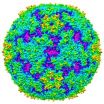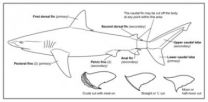(Press-News.org) WEST LAFAYETTE, Ind. - Researchers have discovered critical new details about the structure of a virus that causes potentially fatal brain swelling and paralysis in children, pointing toward designs for antiviral drugs to treat the disease.
The virus, called enterovirus 71, causes hand, foot and mouth disease, and is common throughout the world. Although that disease usually is not fatal, the virus has been reported to cause encephalitis, a potentially fatal illness found primarily in the Asia-Pacific region.
Now, two research teams are reporting new findings about the structure of the virus. One of the teams, from Purdue University, has proposed a way to design antiviral drugs to treat the infection. Findings from that team are detailed in a paper appearing Thursday (March 1) in the online Express issue of the journal Science. Another team, led by researchers at Oxford University, will report its findings in a paper scheduled to appear Sunday (March 4) in the journal Nature Structural & Molecular Biology.
"Taken together, the findings in both papers are useful when you are trying to stop the virus from infecting host cells," said Michael G. Rossmann, Purdue's Hanley Distinguished Professor of Biological Sciences. "The common theme is that they both report for the first time on the structure of this virus, and this tells us how to design compounds to fight the infection."
Rossmann is co-author of a paper written by Purdue postdoctoral research associate Pavel Plevka; Purdue research scientist Rushika Perera; Richard J. Kuhn, a professor and head of Purdue's Department of Biological Sciences; and Jane Cardosa, a researcher at Sentinext Therapeutics in Malaysia.
Both teams used a technique called X-ray crystallography to determine the virus's precise structure, showing similarities to features on related enteroviruses, including poliovirus. However, a key feature is different in that a small molecule called a "pocket factor," located within a pocket of the protective shell of the virus, is partially exposed in EV71.
When the virus binds to a human cell, the pocket factor is squeezed out of its pocket resulting in the destabilization of the virus particle, which then disintegrates and releases its genetic material to infect the cell and replicate.
Researchers led by Rossmann have developed antiviral drugs for other enteroviruses such as rhinoviruses that cause the common cold. The drugs work by replacing the pocket factor with a molecule that binds more tightly than the real pocket factor.
This hinders infection in two ways: The drug molecule fills the pocket, making it difficult for a virus to bind to a human cell. Also, because the drug binds tightly to the pocket, it stabilizes the virus and keeps it from disintegrating and releasing its genetic material into the host cell.
However, in enterovirus 71 - or EV71 - a portion of the pocket factor sticks out of the pocket, exposing a hydrophilic tip, whereas the pocket factors in other related viruses are entirely enclosed in the pocket. In order to hinder EV71 infection, antiviral drugs must have a hydrophilic tip at one end to mimic the pocket factor.
"The major point of this paper is that it suggests how to design a drug to inhibit EV71 infection," Rossmann said.
Hand, foot and mouth disease, an infection most common among young children, sometimes arises in a daycare setting. Of the 427,278 cases of the disease recorded in mainland China between January and May 2010, 5,454 cases were classified as severe, with 260 deaths, according to the World Health Organization.
"Right now, there isn't much you can do for a child who contracts encephalitis," Kuhn said.
Future work will include research aimed at developing an antiviral drug for EV71. The research has been funded by the National Institutes of Health.
INFORMATION:
Writer: Emil Venere, (765) 494-4709, venere@purdue.edu
Sources: Pavel Plevka, 765-494-8712, plevka@purdue.edu
Michael Rossmann, 765-494-4911, mr@purdue.edu
Richard J. Kuhn, 765-494-4407, kuhnr@purdue.edu
Rushika Perera, perera@purdue.edu
Related website:
Michael Rossmann: http://www.bio.purdue.edu/molecular_biosciences/directory.php?refID=81
IMAGE CAPTION:
Purdue researchers created this three-dimensional reconstruction of enterovirus 71, which causes hand, foot and mouth disease and potentially fatal encephalitis. Researchers are reporting new findings about the structure of the virus, proposing a way to design an antiviral drug to treat the infection. (Department of Biological Sciences, Purdue University)
A publication-quality image is available at http://news.uns.purdue.edu/images/2012/rossmann-ev71.jpg
Abstract on the research in this release is available at: http://www.purdue.edu/newsroom/research/2012/120301RossmannEnterovirus.html
Note to Journalists: A copy of the research paper is available by contacting the Science Press Package team at 202-326-6440, scipak@aaas.org
Studies reveal structure of EV71, a virus causing childhood illnesses
2012-03-05
ELSE PRESS RELEASES FROM THIS DATE:
How does cannabis affect working memory?
2012-03-05
A deterioration of working memory is observed in people who consume drugs containing cannabinoid compounds found in cannabis leaves and buds. A team led by Giovanni Marsicano (Inserm Research Unit 862) in collaboration with a team led by Xia Zhang, has recently identified the mechanism by which these substances affect working memory. These researchers have demonstrated for the first time that the adverse effect of cannabinoids on working memory is exerted via receptors located in the glial cells (brain cells present in large numbers and scarcely studied). This effect is ...
John Spencer Ellis and Jairek Robbins Offer Free Rapid Results Video Training for Achieving Fitness and Life Goals
2012-03-05
Do you want to achieve your business goals in the next five years? Your personal goals in three years or so? How about achieving them now?
Anyone interested in rapid results for achieving business or life goals can benefit from a free online training video, "6 Steps for Your Rapid Results in Business and Life." The free online video was developed by personal development and fitness guru John Spencer Ellis and Jairek Robbins, the world's foremost authority at developing creative solutions for achieving results; it is now available online at John Spencer Ellis' ...
American College of Rheumatology releases first classification criteria for polymyalagia rheumatica
2012-03-05
ATLANTA – The American College of Rheumatology has released the first classification criteria for polymyalgia rheumatica – aimed at helping physicians identify patients with this condition, which occurs in persons aged 50 years or older who have recent onset of pain in the shoulders, neck and hips along with other inflammatory symptoms not explained by an alternate diagnosis.
Polymyalgia rheumatica is a relatively common cause of widespread aching and stiffness in older adults. It can be difficult to diagnose because it rarely causes swollen joints or other abnormalities ...
Cocoa may enhance skeletal muscle function
2012-03-05
A small clinical trial led by researchers at UC San Diego School of Medicine and VA San Diego Healthcare System (VASDHS) found that patients with advanced heart failure and type 2 diabetes showed improved mitochondrial structure after three months of treatment with epicatechin-enriched cocoa. Epicatechin is a flavonoid found in dark chocolate.
The results of this initial study has led to the implementation of larger, placebo-controlled clinical trial at UC San Diego School of Medicine and VASDHS to assess if patients with heart failure and diabetes show improvement ...
New computers respond to students' emotions, boredom
2012-03-05
Emotion-sensing computer software that models and responds to students' cognitive and emotional states – including frustration and boredom – has been developed by University of Notre Dame Assistant Professor of Psychology Sidney D'Mello and colleagues from the University of Memphis and Massachusetts Institute of Technology. D'Mello also is a concurrent assistant professor of computer science and engineering.
The new technology, which matches the interaction of human tutors, not only offers tremendous learning possibilities for students, but also redefines human-computer ...
Law that regulates shark fishery is too liberal: UBC study
2012-03-05
Shark fins are worth more than other parts of the shark and are often removed from the body, which gets thrown back into the sea. To curtail this wasteful practice, many countries allow the fins to be landed detached from shark bodies, as long as their weight does not exceed five per cent of the total shark catch. New University of British Columbia research shows that this kind of legislation is too liberal.
A study published this week in the journal Fish Biology analyzes the fin to body weight ratios for 50 different shark species. The authors find the average fin ...
DestinationPro.com - A Unique Online Tool in the Area of Meeting & Event Planning is Now Available
2012-03-05
DestinationPro.com is a solution allowing independent execution of events and incentive programs. If anyone needed to organize a corporate meeting, business trip, training, bonus (incentive) trip for employees, conference, etc., he/she usually took advantage of services provided by one of the specialized agencies (DMCs - Destination Management Company). Based on the client's specification, such agency proposed agenda and individual suppliers (accommodation, restaurants, venues, transportation, logistic, etc.), subsequently ensuring and executing the whole event.
We ...
Holding a mirror to brain changes in autism
2012-03-05
Philadelphia, PA, March 2, 2012 – Impaired social function is a cardinal symptom of autism spectrum disorders (ASDs). One of the brain circuits that enable us to relate to other people is the "mirror neuron" system. This brain circuit is activated when we watch other people, and allows our brains to represent the actions of others, influencing our ability to learn new tasks and to understand the intentions and experiences of other people.
This mirror neuron system is impaired in individuals with ASD and better understanding the neurobiology of this system could help ...
NIH asthma outcome measures aim to maximize research investments, reduce disparities
2012-03-05
WASHINGTON, D.C., March 2, 2012 – Newly proposed asthma outcome measures will help standardize and improve results from the hundreds of millions of dollars the National Institutes of Health (NIH) spends annually to study asthma, according to the Merck Childhood Asthma Network, Inc. (MCAN), the nation's only organization focused solely on childhood asthma. Even though years of research have led to groundbreaking improvements in better understanding and managing asthma, MCAN noted that the inability to compare results across many studies has hindered the nation's efforts ...
Video publication goes viral
2012-03-05
MAYWOOD, Ill. -- A scientific method paper and video by Loyola researchers has gone viral. The video demonstrates a laboratory technique used to study some aspects of mitochondrial dysfunctions in Alzheimer's disease and many other disorders.
It has been accessed by more than 14,000 scientists around the world since it was published in the Journal of Visualized Experiments, a peer-reviewed, PubMed-indexed journal that publishes biological and other scientific research in a video format.
Senior author is Joanna C. Bakowska, DVM, PhD, an assistant professor in the Department ...



